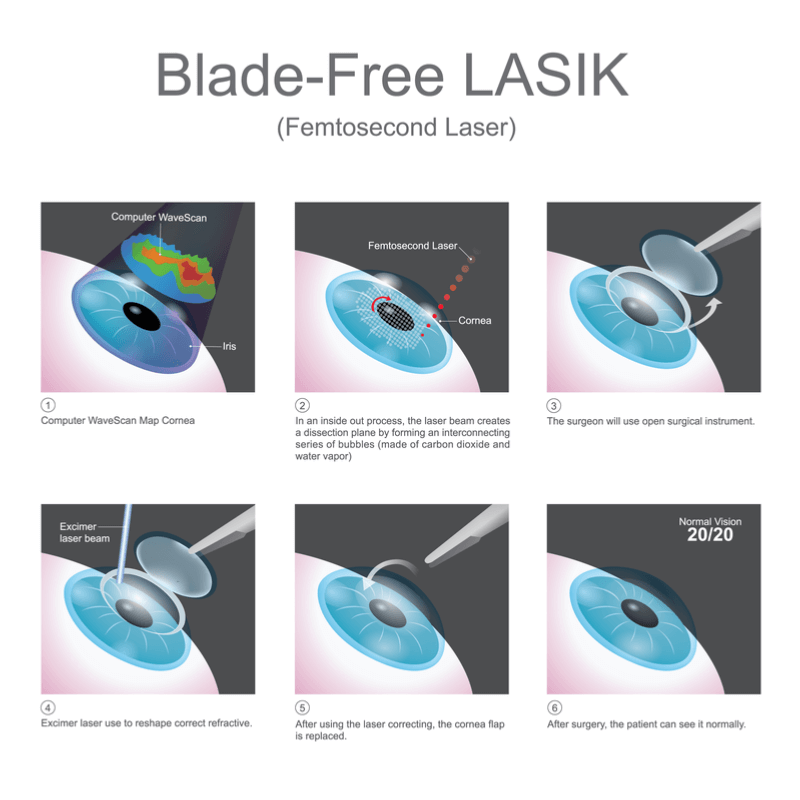
If you’re thinking about LASIK, you might not have known it can be done with and without a surgical blade.
LASIK (an acronym for Laser Assisted In Situ Keratomileusis) was first used in the U.S. in 1991 and has been updated pretty regularly with new laser technologies. The procedure commonly marketed as bladeless LASIK came in 2007, introduced as IntraLase.
Isn’t All LASIK Bladeless LASIK?
Newer LASIK procedures are bladeless, although some eye surgeons bristle at the term “bladeless” since all LASIK procedures cut into the eye surface. The earliest procedure, which is still safely performed today with very few complications, uses a specialized blade.
First, a little background. Myopia (nearsightedness) and farsightedness happen when various parts of the eye change shape and interfere with proper vision. In nearsightedness, the eyeball becomes elongated, disrupting the way the cornea or lens fit on it. Or sometimes they curve on their own and disrupt the conformity. These changes are often genetic and begin to appear in young adulthood.
Farsightedness (hyperopia) occurs when the eyeball is too short and the eye focuses on images behind the retina instead of on it. It can disrupt vision at any distance. All LASIK procedures fix these problems by reshaping the eye, which involves cutting into the surface to create a very thin flap.
Traditional LASIK creates the flap with a surgical blade called a microkeratome. The newer LASIK procedures approved since 1999 use different types of lasers to cut into the eye, creating the “LASIK flap.”
That’s essentially the difference in all LASIK surgery procedures. After the flap is created, the surgeon lifts it and directs a laser underneath it to literally reshape the eye to correct the vision. The flap is put back down and allowed to heal, which takes a week or less.
Is Bladeless LASIK Eye Surgery Safest for Patients?
Because each patient’s eyes are different, it’s best to go with the surgeon’s opinion when it comes to deciding which kind of LASIK surgery to have. Many surgeons use different techniques, taking into consideration complications like glaucoma and previous eye surgeries.
As for safety, the real factor is the surgeon’s skill but overall LASIK is among the safest surgeries. Both laser and microkeratome cutting carry certain risks and benefits.
Microkeratome – Blade vs Bladeless LASIK:
Microkeratome-created flaps:
- Very low risk for detached flaps and other complications
- Possible higher risks for “buttonholes” in flaps
- Higher risk for variation in flap thickness
- Better for patients with glaucoma
- Better for repairing previous LASIK errors
- Takes less time to perform
- Requires less suction, which can be painful for patients
Laser-created flaps:
- Increased risk for edema (swelling) on the flap that can lengthen recovery time
- Lowest risk for flap complications
- No variation in flap thickness
- Temporary light sensitivity
- More expensive
- Better post-surgery vision
- Rarely requires subsequent “touch up” surgery
Is Bladeless Lasik Less Painful Than Traditional LASIK?
Honestly, LASIK surgery is pretty low on the pain scale, especially compared to other surgeries you may have had, such as appendectomy or cholecystectomy (gallbladder removal).
Your surgeon will numb your eyes with drops, and there is little actual pain after the procedure. Many patients feel like there’s something floating around in their eyes, and tearing is pretty common. There may be a little bit of burning or itching while the cornea heals, but nothing approaching actual pain.
Perfect, or near-perfect eyesight is a gift. If you have pretty bad eyesight and are tired of wearing glasses or contact lenses, you should consider LASIK. Contact us for a free consultation or visit our Atlanta Lasik Eye Surgery Center.
Contact Us
If you have more questions about LASIK procedures, get in touch with us.
Related Blogs

Who Should Not Have Laser Eye Surgery
Laser eye surgery, commonly known as LASIK (Laser-Assisted In Situ Keratomileusis), has revolutionized the world of vision correction. It’s a procedure that has enabled millions

LASIK eye surgery: What is LASIK and how does it work?
What Is LASIK? Experts categorize LASIK as a refractive eye surgery in which lasers are used to correct vision problems. LASIK corrects several refractive errors,

Everything You Need To Know About The Lipiflow Treatment
LipiFlow is often referred to as a ground-breaking technology that is able to treat dry eye issues caused by meibomian gland dysfunction, or MGD. Experts

